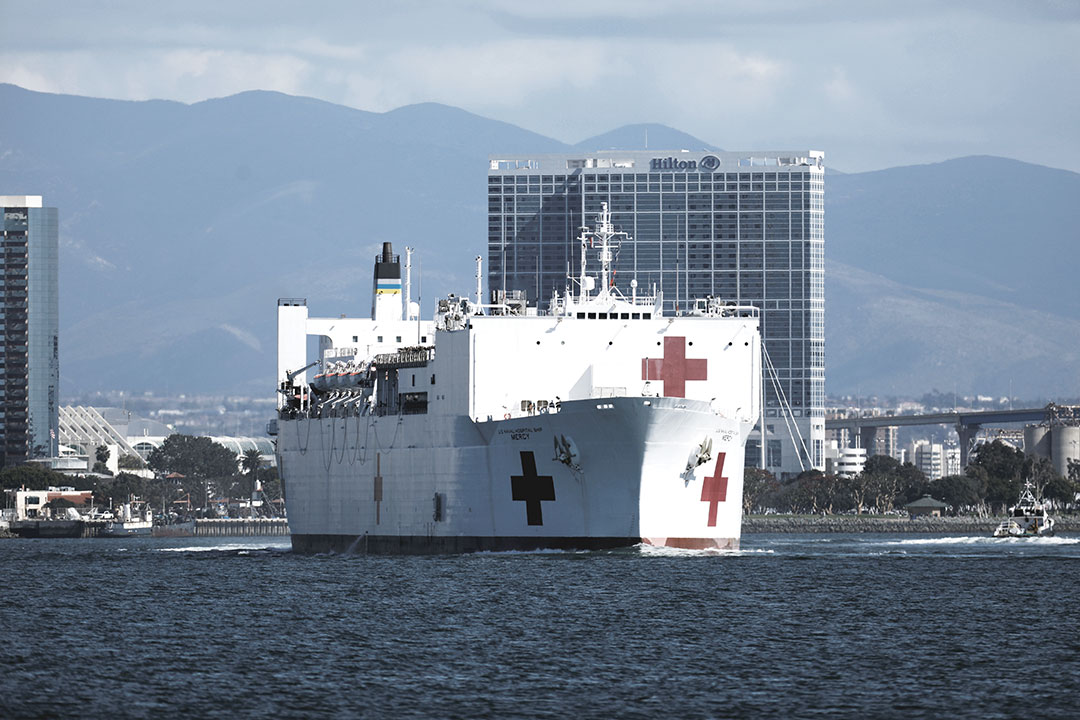THE WATCH Staff
As the COVID-19 pandemic infected hundreds of thousands worldwide in late 2019 and early 2020, the U.S. military aggressively responded by assisting civil health authorities in tasks that ranged from delivering food to building temporary hospitals and deploying medical ships. While agencies such as the U.S. Centers for Disease Control, the U.S. Department of Health and Human Services and the Federal Emergency Management Agency (FEMA) took the lead in the pandemic response, the military support effort involved thousands of personnel and covered all states, territories and Washington, D.C. U.S. Northern Command (USNORTHCOM) leads the 14 Department of Defense COVID-19 operational efforts. “There is nothing more sacred than being right here at home defending the homeland,” said Gen. Terrence J. O’Shaughnessy, commander of USNORTHCOM and the North American Aerospace Defense Command. “Our commander in chief has declared war on COVID-19. We are a part of that as a whole-of-America, whole-of-nation approach, and we are incredibly proud to be a part of that mission.”
U.S. NATIONAL GUARD DEPLOYED
By early June 2020, more than 46,000 members of the National Guard had been activated across the nation to assist efforts to mitigate and control the COVID-19 pandemic.
The troops supported community-based testing sites, created enhanced medical capacity, provided logistical support and transportation of supplies, and helped state emergency operations centers.
Guard members also helped build medical facilities and worked to clean and disinfect common spaces in hard-hit areas.
All states, under Title 32 status, mobilized their National Guard troops. U.S. Defense Secretary Mark Esper said the Guard units were supporting drive-through testing sites, conducting food delivery to vulnerable populations, and helping states plan and coordinate their local responses.

FLOATING HOSPITALS
FEMA Administrator Peter Gaynor announced in late March 2020 that two U.S. military hospital ships would be deployed to free up local beds for COVID-19 patients. The USNS Mercy traveled from its home port of San Diego, California, to Los Angeles, and the USNS Comfort, which is stationed in Norfolk, Virginia, headed to New York City. The ships, which each have 1,000 beds, originally were not sent to treat coronavirus patients. Mercy “will serve as a referral hospital for non-COVID-19 patients currently admitted to shore-based hospitals and will provide a full spectrum of medical care to include critical and urgent care for adults,” Gaynor said, according to a UPI report. “This will allow local health professionals to focus on treating COVID-19 patients and for shore-based hospitals to use their intensive care units and ventilators for those patients.”
Demand for hospital beds to treat coronavirus patients became so great, however, that the Comfort was reconfigured to accept COVID-19 patients as New York became the epicenter of the pandemic in the U.S.
The floating hospitals are staffed by medical and support personnel from the U.S. Navy’s Bureau of Medicine and Surgery. Civil service mariners operate the ships.
FIELD HOSPITALS
The U.S. Army Corps of Engineers announced in March 2020 that it planned to convert more than 10,000 empty hotel and college dorm rooms into hospital rooms to treat COVID-19 cases in New York City and was considering similar operations for Washington and California.
“These hotels are empty. The people don’t have jobs,” Lt. Gen. Todd T. Semonite, chief of engineers and commanding general of the U.S. Army Corps of Engineers, told reporters. “We’ll go in and cut a contract and be able to have the state set up a lease for that particular facility, and then we would take the building over. And in an exceptionally short amount of days we would go in and turn this into an ICU-like facility,” he said, referring to hospital intensive care units.
The military response also included the establishment of field hospitals in New Jersey, New York and Washington. The 627th Hospital Center from Fort Carson, Colorado, was deployed to Joint Base Lewis-McChord, Washington, to support medical efforts in the Seattle area. The 531st Hospital Center from Fort Campbell, Kentucky, deployed to Joint Base McGuire-Dix-Lakehurst, New Jersey, to set up a field hospital in New York City, and the 9th Hospital Center from Fort Hood, Texas, deployed to the same base to support New York City.
A 450-person U.S. Navy Medical Unit also deployed to Texas and New Orleans. By early June 2020, the military was supporting 24 hospitals and 11 alternate care facilities across the country. In New York City alone, 797 military medical personnel were embedded in 11 hospitals.
CRITICAL SUPPLIES
As part of the whole-of-government approach to fighting the pandemic, the U.S. Department of Defense (DOD) agreed to provide medical supplies and capabilities to the Department of Health and Human Services. Secretary Esper said in mid-March 2020 that the DOD would release 5 million respirator masks and 2,000 ventilators from its strategic reserves.
Defense personnel planned to train civilian operators on how to use the military’s ventilators because they have distinct differences from those in civilian use.
Additionally, the Pentagon said it would make 16 certified testing labs available to nonmilitary personnel to trace the spread of the virus. “I’ve made it clear that we will continue to support the administration’s comprehensive efforts and the country every step of the way, while ensuring our nation’s security remains the top priority of the Department of Defense,” Esper said, according to his department’s website.

